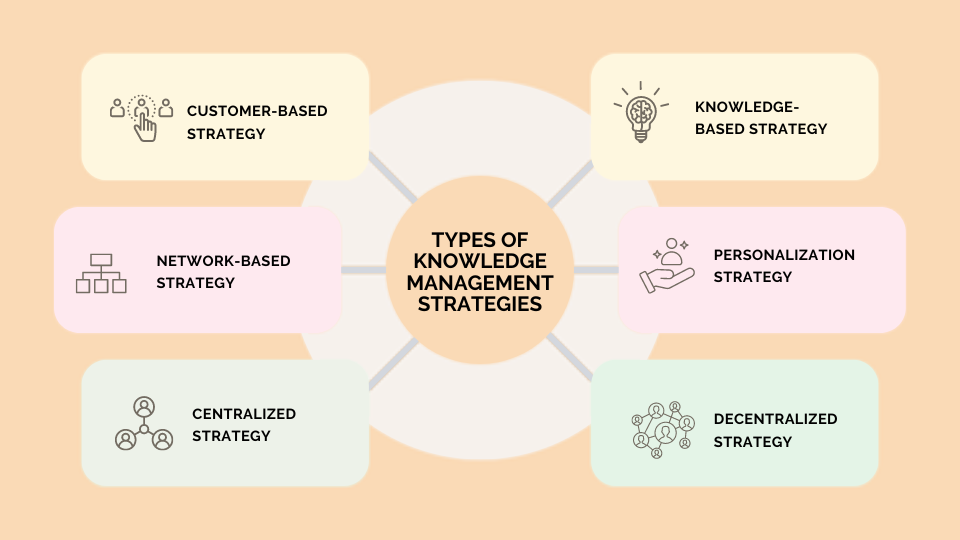Your company’s knowledge is an invaluable resource that includes customer information, innovative ideas, and data on your employees, products, and services.
But what if this knowledge is scattered and inaccessible to the rest of your team? This is why you need a knowledge management strategy.
A well-defined knowledge management strategy can help you organize your company’s knowledge, manage business risks, and maintain smooth operations.
This blog explores knowledge management strategies and shares steps to create an effective knowledge management system.
What is a knowledge management strategy?
A knowledge management strategy is a plan that details how you gather, store, manage, and share information within and outside your organization.
Using this plan, you can define how employees capture and share customer-facing and internal knowledge, thus creating a knowledge-sharing culture.
52 % of respondents say that changes in the workforce have made them proactively develop internal knowledge management strategies- Deloitte
When employees leave the company, essential knowledge may be lost. To prevent this, it is a good policy to instill the habit of developing knowledge documents as they go.

Essential components of a knowledge management strategy
A knowledge management strategy comprises many parts that work together to deliver the strategic goals of a business.
People: Your staff should practice a knowledge-sharing culture. Encourage critical stakeholders with well-defined roles and responsibilities to support the system by sharing appropriate knowledge and providing knowledge resources.
Processes: Written process documents provide organized steps for collecting, managing, and sharing information. When processes are transparent and well-designed, the knowledge system works better.
Information: Information is organized and stored to make it readily available and easy to use according to best practices and security policies.
Technology: You should adopt a knowledge management system to implement your plan. The software should be able to integrate with the platforms you already use to store information.
Types of knowledge management strategies
There are many ways to approach knowledge management. The following are the most common approaches to knowledge management strategy.

Customer-based strategy
The customer-based strategy utilizes a customer-first approach in analyzing customer needs to inform how the strategy will be designed.
It involves organizing knowledge in a self-help section where customers can easily access information.
Data about customers is used to develop this strategy to improve the customer experience strategy. For example, support teams can use past questions from customer tickets to create articles with answers for future customers.
Knowledge-based strategy
This strategy emphasizes gathering knowledge from different sources for storage and distribution. Systems are put in place to prioritize collective knowledge.
It involves a knowledge base that acts as a central repository of information. This can be used for either customer-facing or internal systems.
Network-based strategy
In the network-based strategy, a company uses a network system to store and share information. One or more platforms can be used to access the information from different locations. Interconnected systems and technologies are used to communicate over the internet.
Centralized strategy
A centralized strategy combines all resources in one place. It involves a centralized knowledge base that can either be a physical library or a digital archive. Such a strategy allows for consistency and accuracy of knowledge.
Personalization strategy
The focus of this strategy is for employees to share knowledge personally through mentorship programs. It includes methods such as training or personalized onboarding where experts give guidance to other employees.
Decentralized strategy
This is a strategy where information is kept in multiple places. Responsibility and ownership of knowledge is distributed across the company.
The business accesses different information from different people and areas. This helps to avoid the risk of data or knowledge loss.
Businesses can employ one or more of these strategies depending on their objectives. Analyze your needs to know the type of strategy that best fits you.
Why do you need a knowledge management strategy?
A knowledge management strategy can help you achieve company goals. The following are some of the benefits of having a knowledge management strategy in place.
Improves customer experience through fast issue resolution
A knowledge base provides troubleshooting and user manuals that make it easy for the support team to find information to solve customer issues quickly and reduce ticket resolution time.
Enhances decision making through easily accessible knowledge
A knowledge management strategy makes information accessible through a knowledge repository that empowers employees to make better decisions.
A central knowledge store captures knowledge from several areas, giving employees a broader range of customer insights.
Aids collaboration across teams
When employees share knowledge, solutions become easier to find. Productivity increases due to fast issue resolution. Through cross-functional team collaboration, your support staff can leverage the knowledge of company experts to provide solutions faster.
Promotes better customer service through self-help solutions
A knowledge management strategy provides simple customer self-service solutions through an external knowledge base that allows customers to find answers directly and solve problems on their own. As a result, there is an overall improvement in customer service.
Speeds up the employee onboarding process
New employees can learn directly from a pool of information already existing in a knowledge base. A good knowledge base design shortens the time it takes to train new employees.
Helps manage risks
A good knowledge management plan prepares for the unexpected by having backup plans to reduce risk and ways to get things back on track if problems arise. Data is backed up, security measures in place, and privacy policies accessible and well understood.
Boosts efficiency of support staff by avoiding duplication of work
A knowledge management strategy saves time by enabling the reuse of past solutions from a central knowledge base, boosting support efficiency.
Steps in developing a knowledge management strategy
Your company’s knowledge is its secret weapon. But how do you capture, share, and use it to win? Follow these steps to develop your strategy.
Identify your knowledge management requirements
You must examine your needs before developing a strategy. This means you must articulate your goals and objectives clearly.
Gather all the requirements that the strategy needs to fulfill. You must also understand the company culture and processes. All this forms a foundation for a knowledge management strategy.
Evaluate your existing knowledge management position
Find out how you currently capture, organize, and share knowledge. You should also figure out where all the knowledge resources in your company currently reside to help you set goals and formulate a good content planning strategy.
Choose the best tools to implement your strategy
Evaluate how the knowledge management software available on the market aligns with your needs and objectives. Pick the right tools for your strategy and budget. It should capture and store knowledge as well integrate with your other software such as a help desk software.
Plan the knowledge management strategy
This step is for deciding how to put the knowledge management strategy into practice. Develop an action plan on how employees will use the strategy. Create a user manual and policy guidelines for all staff to follow. Plan how often you will update the strategy.
Bring everyone on board
Once the strategy is in place, you need to involve everyone. Share the action plan and make guide pages, FAQs, templates, and knowledge base articles readily available to all staff.

Empower staff through knowledge management system training and ensure all stakeholders are aware of the strategies put in place.
Organize your knowledge management resources
Organize your knowledge resources. Categorize them into sections and subsections to make them easy to use and access. You can do this using a directory or index of resources.
Set key performance indicators
Key performance indicators help you measure the success of your strategy. Set these metrics to help you know what works and what doesn’t. Use customer sentiment and feedback to measure the effectiveness of your strategy over time.
Continuously improve and update the strategy
The business landscape is continually changing. Continually improve your strategy to be up to date with industry standards. You should check out other companies’ strategies for ideas.
Monitor the knowledge management resources and strategies
Monitor your knowledge resources constantly to ensure they meet your goals. Ensure that you have dedicated time for employees to evaluate and support your strategy.
Examples of knowledge management strategies
Successful companies understand the importance of having knowledge management strategies in place to disseminate information and streamline business processes. Following are some examples of companies with knowledge management strategies in action.
BoldDesk
Our website has an external knowledge base as a central repository of knowledge. The BoldDesk knowledge base has helpful articles and how-to guides for customer support teams and customers. In it, information is organized into sections and subsections.
Its search functionality helps users find information quickly. Additionally, BoldDesk links to multiple support channels for customers who need further assistance, improving the overall customer experience strategy.
Microsoft
Microsoft’s SharePoint tool offers a platform for users to collaborate and share knowledge. The Microsoft Teams tool gives a platform for users to share knowledge resources.
The company also has a powerful search across its platforms for users to find information quickly.
Google is well known for being a knowledge-centered company. It uses knowledge management strategies in the following ways:
- Internal search: Google’s internal search engine lets employees quickly find information across many platforms.
- Knowledge repository: Google maintains an extensive knowledge base of best practices through documentation.
- AI-powered knowledge: Google uses machine learning to analyze patterns in knowledge usage and predict what information may be relevant to users.
Formulate an effective knowledge management strategy for success
Developing a knowledge management strategy can help your company leverage the collective knowledge of its employees and documentation.
Sharing knowledge, picking the right tools, and always trying to do better helps you optimize resources and grow your business.
Use BoldDesk’s robust and customizable knowledge base software to store and organize information about your brand as part of your knowledge management strategy.
Contact us and book a live demo to learn more about BoldDesk’s knowledge base software. Sign up for a free trial to get access today.
I hope this blog helped you learn more about knowledge management strategies and how to create a suitable plan for your business. Feel free to share your thoughts and feedback in the comment section below.
Related articles


















 Email Ticketing System
Email Ticketing System Shared Inbox Software
Shared Inbox Software Multi Brand Help Desk
Multi Brand Help Desk Internal Help Desk Software
Internal Help Desk Software Trouble Ticketing Software
Trouble Ticketing Software Mobile Help Desk
Mobile Help Desk 


















